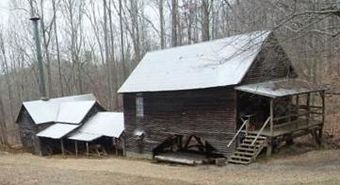Jarrell Plantation facts for kids
The Jarrell Plantation State Historic Site is a special place in Juliette, Georgia, United States. It was once a large farm where cotton was grown. The farm was started by John Jarrell and people who were forced to work without pay. Today, it is one of the best examples of a "middle class" Southern farm from a long time ago.
All the buildings and items at Jarrell Plantation belonged to the Jarrell family. They farmed this land for over 140 years. The site is located in the red clay hills of Georgia's Piedmont region. It was added to the National Register of Historic Places in 1973. It is now a Georgia state park in Jones County.
Contents
A Look Back: The History of Jarrell Plantation
Farming Before the Civil War
Before the Civil War, John Jarrell's farm was one of many cotton farms in the Southern United States. These farms grew most of the world's cotton. John Jarrell, like many farmers, used a machine called the cotton gin. This machine was invented in 1793 by Eli Whitney. It made it much easier to clean cotton, even in hilly areas like Georgia.
John Fitz Jarrell built the first main building on the farm in 1847. Like other cotton farms of that time, John Jarrell ran the farm with his family. He also forced African American people to work there without freedom or pay. By 1860, Jarrell had 39 people working on his 660-acre farm. Even though cotton was the main crop, the farm also grew food and raised animals.
Surviving Tough Times
The 1860s were a very difficult time for the farm. It survived a serious illness called typhoid fever. It also went through Sherman's March to the Sea, a major event during the Civil War. After the war, the enslaved people were freed. This period was known as Reconstruction.
After the Civil War, John Jarrell continued to farm. He worked with people who had once been enslaved. He also made his farm bigger, to nearly 766 acres. However, the formerly enslaved people began to leave the farm in John Jarrell's later years.
New Beginnings and Growth
John Jarrell passed away in 1884. One of his sons, Benjamin Richard "Dick" Jarrell, decided to come home. He had been a teacher, but he returned to the farm and built his own family home in 1895. The farm had been making sugar from sugarcane since 1864. Dick Jarrell made the farm even more modern. He added a mill complex with a steam-powered sawmill, a cotton gin, a gristmill, a shingle mill, and a planer.
In 1920, Dick Jarrell and his five sons and two nephews built a second, larger home. This house was 5,000 square feet and made of strong pine wood. It was built in a style popular in the 1850s.
Becoming a Historic Site
In 1974, Dick Jarrell's nine grown children gave the farm to the State of Georgia. They wanted to save the farm and teach future generations about its history. Today, the Georgia Department of Natural Resources manages the 200-acre historic site. It is open to the public from Thursday through Sunday.
The site has many buildings and structures to explore. These include the farmhouse, a sawmill, a cotton gin, a gristmill, a shingle mill, a planer, a sugar cane press, a syrup evaporator, a workshop, a barn, and other small buildings.
Images for kids
See also












